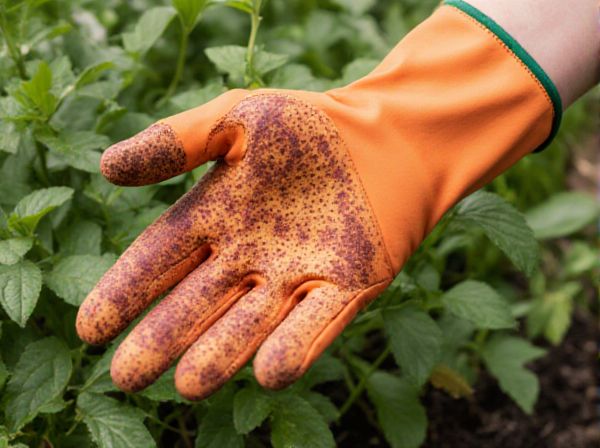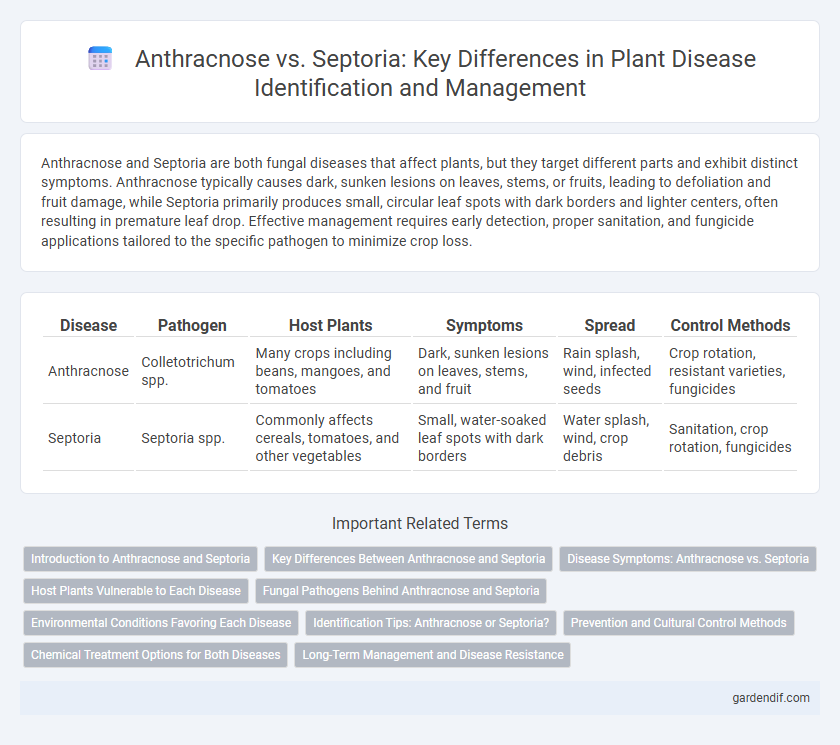
Anthracnose vs Septoria Illustration
Anthracnose and Septoria are both fungal diseases that affect plants, but they target different parts and exhibit distinct symptoms. Anthracnose typically causes dark, sunken lesions on leaves, stems, or fruits, leading to defoliation and fruit damage, while Septoria primarily produces small, circular leaf spots with dark borders and lighter centers, often resulting in premature leaf drop. Effective management requires early detection, proper sanitation, and fungicide applications tailored to the specific pathogen to minimize crop loss.
Table of Comparison
| Disease | Pathogen | Host Plants | Symptoms | Spread | Control Methods |
|---|---|---|---|---|---|
| Anthracnose | Colletotrichum spp. | Many crops including beans, mangoes, and tomatoes | Dark, sunken lesions on leaves, stems, and fruit | Rain splash, wind, infected seeds | Crop rotation, resistant varieties, fungicides |
| Septoria | Septoria spp. | Commonly affects cereals, tomatoes, and other vegetables | Small, water-soaked leaf spots with dark borders | Water splash, wind, crop debris | Sanitation, crop rotation, fungicides |
Introduction to Anthracnose and Septoria
Anthracnose and Septoria are both fungal diseases that affect a wide variety of plants, causing leaf spots, blights, and defoliation. Anthracnose is caused by fungi in the genera Colletotrichum and Gloeosporium, characterized by dark, sunken lesions often on fruits, stems, or leaves, whereas Septoria is primarily caused by Septoria species, producing small, water-soaked spots with distinct black pycnidia on leaves. Both diseases significantly impact crop yield and quality, making early identification and management crucial for agricultural productivity.
Key Differences Between Anthracnose and Septoria
Anthracnose primarily affects leaves, stems, and fruits, causing dark, sunken lesions, while Septoria targets leaves with grayish or brownish spots surrounded by yellow halos. The fungal pathogens responsible differ: Colletotrichum spp. cause Anthracnose, whereas Septoria spp. trigger Septoria leaf spot. Anthracnose thrives in warm, humid conditions and spreads through rain splash and infected plant debris, contrasting with Septoria's preference for moderate temperatures and reliance on airborne spores for dissemination.
Disease Symptoms: Anthracnose vs. Septoria
Anthracnose causes irregular, sunken lesions with dark borders on leaves, stems, and fruits, often leading to defoliation and fruit rot. Septoria primarily presents as small, water-soaked spots that develop into circular lesions with gray centers and dark margins, mainly affecting leaves and causing early leaf drop. Both diseases significantly reduce plant vigor, but anthracnose symptoms are typically more aggressive and widespread.
Host Plants Vulnerable to Each Disease
Anthracnose primarily threatens crops such as beans, cucumbers, and tomatoes, causing dark, sunken lesions on leaves and stems. Septoria mainly affects tomatoes by producing small, circular leaf spots with dark borders, leading to defoliation and reduced yield. Both diseases thrive in warm, humid conditions, requiring vigilant monitoring for effective management in susceptible host plants.
Fungal Pathogens Behind Anthracnose and Septoria
Anthracnose primarily results from fungal pathogens in the Colletotrichum genus, which infect a variety of plants causing dark lesions and fruit rot. Septoria is caused by fungi in the Septoria genus, leading to leaf spot diseases characterized by small, circular, brown lesions with dark borders. Both pathogens thrive in moist environments, significantly impacting crops like cereals, vegetables, and fruits by decreasing yield and quality.
Environmental Conditions Favoring Each Disease
Anthracnose thrives in warm, wet environments with temperatures between 77degF and 86degF combined with high humidity and frequent rainfall, which promote spore germination and infection. Septoria prefers moderate temperatures around 60degF to 75degF and high moisture levels, particularly leaf wetness from rain or dew, facilitating lesion development and fungal spread. Both diseases require moist conditions but differ in optimal temperature ranges, influencing their prevalence in distinct climatic regions.
Identification Tips: Anthracnose or Septoria?
Anthracnose typically presents as dark, sunken lesions with concentric rings on leaves, stems, and fruits, often causing leaf curling and defoliation, while Septoria manifests as small, circular, water-soaked spots with gray centers and dark brown margins primarily on the lower leaf surfaces. Identification relies on close examination of lesion shape, color, and distribution; anthracnose lesions tend to be larger and more irregular, whereas Septoria spots appear more uniform and scattered. Laboratory analysis or microscopic inspection can confirm the presence of Septoria's distinctive pycnidia or anthracnose's acervuli, aiding accurate diagnosis.
Prevention and Cultural Control Methods
Managing anthracnose and Septoria effectively relies on implementing robust prevention and cultural control methods, such as crop rotation and removing infected plant debris to reduce fungal inoculum. Resistant plant varieties and proper spacing enhance air circulation, mitigating the humid conditions that favor fungal growth. Regular monitoring and timely pruning ensure early detection and reduction of disease spread, crucial for maintaining healthy crops.
Chemical Treatment Options for Both Diseases
Chemical treatment options for anthracnose primarily involve fungicides containing chlorothalonil, thiophanate-methyl, or azoxystrobin, which effectively target Colletotrichum species responsible for the disease. Septoria leaf spot management relies on fungicides with active ingredients such as strobilurins, chlorothalonil, and copper-based compounds to suppress Septoria pathogens. Both diseases require timely application during early infection stages to maximize fungicide efficacy and prevent widespread crop damage.
Long-Term Management and Disease Resistance
Effective long-term management of Anthracnose and Septoria relies on integrated disease resistance strategies, including crop rotation with resistant cultivars and proper field sanitation to reduce inoculum sources. Employing fungicides with different modes of action in rotation helps prevent pathogen resistance development in both diseases. Continuous monitoring and breeding for genetic resistance remain crucial for sustainable control and minimizing yield losses over time.
Anthracnose vs Septoria Infographic

 gardendif.com
gardendif.com